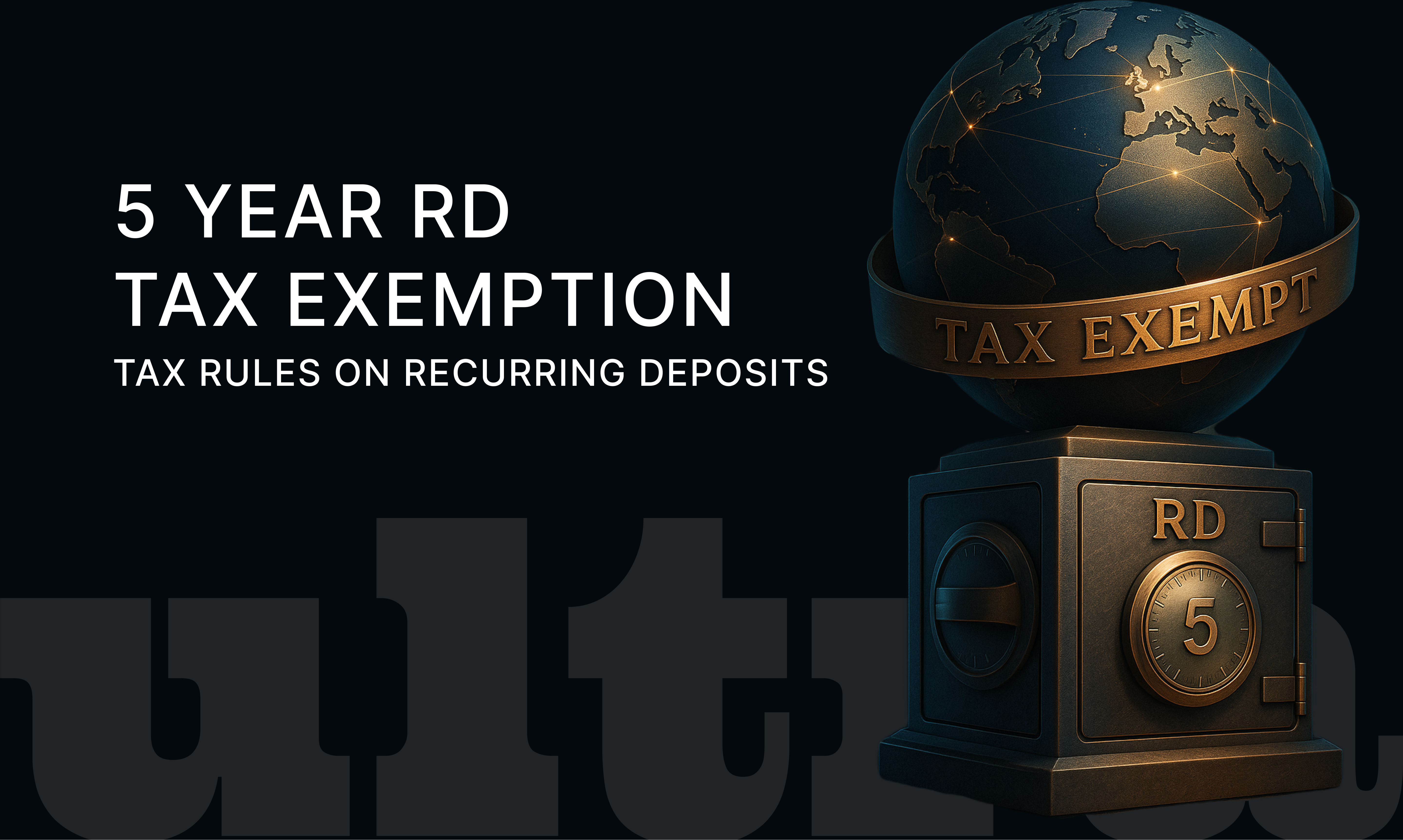5 Year RD Tax Exemption: Meaning, Interest Rates & Tax Rules
15 July 2025 · Sachin Gadekar
Is a 5-Year Recurring Deposit Tax-Free? Everything You Need to Know

What is a Recurring Deposit (RD)?
Recurring Deposits (RDs) are a popular saving option for disciplined savers looking to build a corpus with small monthly contributions. But many people wonder — does a 5-year RD qualify for tax exemption like a fixed deposit (FD) under Section 80C?
In this guide by Ultra, we clarify the tax rules for RDs, compare them with fixed deposits, and share smart ways to handle tax on RD interest.
Also, don’t miss our handy tips to explore higher return options better than FD if you want to earn more without compromising on safety.
A recurring deposit is a type of term deposit where you invest a fixed sum every month for a pre-decided tenure — usually 6 months to 10 years. Unlike a lump sum FD, RDs help develop a saving habit with monthly installments.
At maturity, you receive the principal plus accumulated interest. To learn more about how to manage and break your FDs safely, check our detailed guide on how to break an FD in SBI Bank.
Recurring Deposit Interest Rates in India
Recurring deposit interest rates vary depending on the bank or post office. They usually range from 5% to 7% per annum. Senior citizens may get an extra benefit of 0.25% to 0.75% per annum.
Keep in mind that while RDs and FDs offer fixed returns, sometimes overdrafts against FD or breaking an FD early may affect the final interest earned — so plan your tenure and amount wisely.
Does a 5-Year RD Get Tax Exemption?
This is a common misconception. Many savers think a 5-year RD qualifies for tax benefits under Section 80C, just like a 5-year tax-saving FD. But the truth is:
5-year tax-saving FD: Eligible for tax deduction under Section 80C up to ₹1.5 lakh.
5-year RD: NOT eligible for any Section 80C deduction.
Only the Post Office 5-Year RD may provide limited tax benefit, but its interest income is still taxable.
How is RD Interest Taxed?
Interest earned on an RD is fully taxable. It is treated as ‘Income from Other Sources’ and taxed according to your slab rate.
Banks and post offices deduct TDS at 10% if total interest exceeds ₹40,000 in a financial year (₹50,000 for senior citizens).
To know more about how TDS works for NRIs and how to manage TDS on deposits, read our detailed guide on TDS on NRI FD Interest.
How to Calculate Tax on RD Interest
Here’s how to manage RD tax properly:
Calculate total RD interest: Sum up interest from all your RDs in a financial year.
Add to taxable income: Declare it in your Income Tax Return (ITR) under ‘Income from Other Sources’.
Check TDS: If the bank deducted TDS, adjust it against your final tax. Claim a refund if excess TDS was cut.
Use Form 15G/15H: Submit if your total income is below the exemption limit to avoid unnecessary TDS.
Better Options to Save More Than RD
If you’re looking for better-than-RD returns, compare RDs with FDs, bonds, or market-linked options. While RDs are safe, they may not give the highest post-tax returns.
Check out some smart alternatives better than FD — many of which offer higher yield, flexible terms, and tax-efficient structures.
Comparison: 5-Year RD vs 5-Year Tax Saving FD
| Feature | 5-Year RD | 5-Year Tax Saving FD |
|---|---|---|
| Eligible under Section 80C | No | Yes (up to ₹1.5 lakh) |
| Interest Taxability | Fully taxable | Fully taxable |
| TDS Deduction | Yes, above ₹40,000 | Yes, above ₹40,000 |
| Lock-in Period | Flexible | Fixed 5 years |
| Premature Withdrawal | Allowed with penalty | Not allowed |
Final Thoughts
To sum up: a 5-year RD does not provide tax exemption under Section 80C, but it remains a safe, reliable saving tool. If you want both safety and higher returns, diversify with tax-saving FDs, bonds, or digital fixed-income options.
At Ultra, we help you discover the best opportunities beyond traditional FDs and RDs — so your money works smarter and grows steadily.
FAQs on 5-Year RD Tax Exemption
Q1. Does a 5-year RD offer any tax benefit?
No. Unlike 5-year tax-saving FDs, a 5-year RD does not qualify under Section 80C.
Q2. Is RD interest taxable every year?
Yes. RD interest is added to your annual income and taxed per your slab.
Q3. How to avoid TDS on RD?
If your income is below the basic limit, submit Form 15G/15H to avoid TDS.
Q4. Is it better to invest in FD instead of RD?
It depends on your goals. For lump sum investment with tax benefits, a 5-year tax-saving FD is better. For regular monthly saving, RD is ideal.
Q5. What to do if I want higher returns than RD?
Explore better options like bonds, invoice discounting, or alternative fixed income products. Learn more here: Better than FD: Higher Return Options